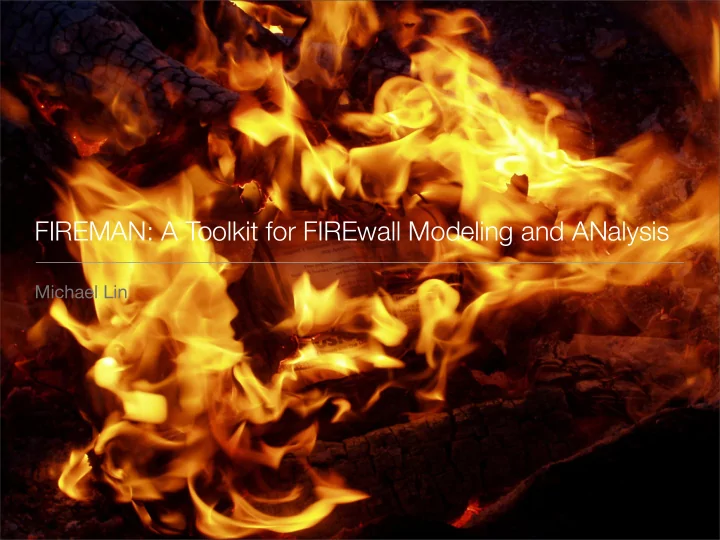

FIREMAN: A Toolkit for FIREwall Modeling and ANalysis Michael Lin
All about firewalls • A firewall is only as good as its configuration • Big deal, it should be easy to configure a firewall, right? • Basically... no. “A Quantitative Study of Firewall Configuration Errors” showed that 100% of firewalls in a study were vulnerable due to bad configuration • Firewall rules are easy to manage for simple rulesets, but as the rulesets grow, the configurations grow too
What can we do about this? • Manually analyzing firewall rules is tedious and error-prone... • Static analysis to the rescue! • Firewall rules are ideal for static analysis: simple and logic-based • FIREMAN is a system for doing static analysis on firewall rulesets and automatically finding configuration errors
What are configuration errors? • 3 types of “errors” • Policy violation • The configuration violates the high-level semantics of the rules • Inconsistency • Inefficiency
Inconsistencies • Shadowing • An earlier rule makes a later rule impossible, ie. “deny all” “accept tcp 192.168.0.0/16 any” • Generalization • An earlier rule is a subset of a later rule which does the opposite thing • Correlation • Two rules cover the same packets with different actions • Generalization and correlation can be intentional, so they are classified as warnings rather than errors
Analyzing firewall rules Input • How do we formally represent a firewall ACL? • Rule graphs <P, drop> • Good for individual firewalls, but for networks with <P2, drop> multiple firewalls we need a little more information • ACL trees <P3, accept> • Abstracted representations of all relevant nodes in a Policy network Action
Formalizing correctness • Important variables: • A j - All packets accepted before the j th rule • D j - All packets denied before the j th rule • F j - All packets sent to a different rule path before the j th rule • R j - All packets not covered by the above by the j th rule • I - input
Formalizing correctness • Using the previously defined variables and errors, we can make formal logic statements about firewall rules • Some examples for <P , accept> rules: • P j ⊆ R j ⇒ good - This is a “good” rule • P j ⊆ D j ⇒ shadowing • P j ∩ D j ≠ ∅ ⇒ correlation
Example • P 1 : accept tcp 192.168.0.0/16 any P 2 : deny tcp 192.168.0.3/32 any • A 1 = 192.168.0.0/16 D 1 = Ø R 1 = All packets - 192.168.0.0/16 • A 2 = 192.168.0.0/16 D 2 = 192.168.0.3/32 R 2 = All packets - 192.168.0.0/16 • P 2 ⊆ A 2 ⇒ shadowing!
Bringing it all together... • In more complex firewalled networks, there might be separate logic trees for each firewall • We need some way to ensure that configurations are policy-consistent across the network... • ∀ j ∈ m , I j = I - for a network with m firewalls, the input from the j th firewall should match all other inputs • I ∩ blacklist ≠ ∅ ⇒ policy violation • whitelist ⊄ I ⇒ policy violation
So how well does it work? • Represented firewall rule graphs using binary decision diagrams, implemented and tested on 3 (only?) real-life firewalls • Found previously unnoticed policy violations in all 3, inconsistencies and inefficiencies in some • Performance isn’t a huge issue since this is an offline analysis, but it turns out to not be too bad: O( n ) • So FIREMAN does a good job of analyzing firewalls, and static analysis is demonstrably effective at finding firewall configuration errors
Take away FIREMAN rocks!
Really, though... • Avi Wool’s study covered 37 firewalls and found problems in every one of them • This covered 3 and found problems in every one of them • A lot of work in this area is actually about managing firewalls...
Take away Ease of use is just as important as technical soundness
Recommend
More recommend